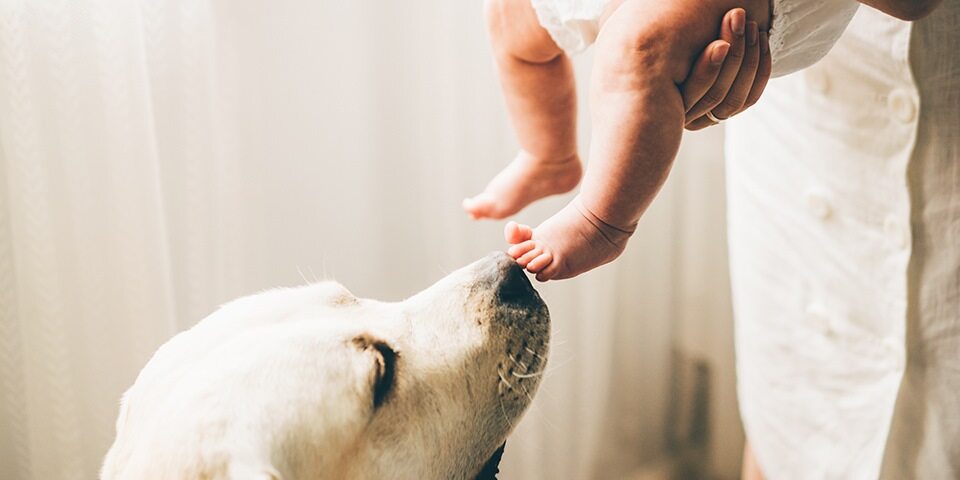How to introduce dogs and babies

Before you were expecting, your fur baby was your only baby — but that’s all about to change. While it feels like you have a million things to prepare for before your baby arrives, you’ll probably want to add, “How do I introduce my dog to my newborn?” to your to-do list. Here’s how to plan for the day when your fur baby meets your new baby.
What safety precautions should you take before introducing a baby to a dog?
Whether you’re newly pregnant or trying to conceive, there are things you can do now to better prepare everyone — you, your dog and your baby — for cohabitation. Depending on the type of questions you have, reach out to your doctor or veterinarian.
Train your dog ahead of time
Contrary to popular belief, it is possible to teach an old dog new tricks! And if you’re pregnant, it’s a good idea to make sure your pup has learned some basic obedience skills. The American Society for the Prevention of Cruelty to Animals (ASPCA) recommends teaching these commands1:
- “Sit” and “down”
- “Stay” and “settle”: ideal for teaching your dog to calmly wait at doors when told
- “Leave it” and “drop it”: These commands will prove useful for protecting all those new stuffed animals, blankets and pacifiers!
Also think about what skills your dog may need to brush up on, such as:
- Not jumping on people as a greeting: This is especially important when the baby is being held.1
- Going into a crate when told: Your dog’s crate should be a haven, a comfortable place to go — especially when things are hectic.2
- Coming to you when called.1
- Not pulling when leash walking: This is important if you plan to take both your dog and your baby on walks. Also note how your dog reacts when encountering other people or animals on walks. If you sense any aggression, consider walking your dog solo or hiring a dog walker.3
- Hand targeting: Also called “nose target” or “touch,” this training teaches your dog to touch their nose to your hand. Great for timid dogs, this is an easy way to engage with your dog when the baby is around.1 The American Kennel Club has more tips on how to teach your dog to nose target.
Does the idea of all this training stress you out? That’s OK! If you don’t have the time or bandwidth, consider finding a personal dog trainer, an obedience school or a class.
Build some flexibility into your routine
Dogs appreciate routine, and with the arrival of a baby, that routine is about to change — a lot.1 If your dog lives by a fairly consistent schedule, now is the time to mix things up. Here are a few ideas:
- If you currently feed your dog at precisely 6 o’clock every day, try feeding — and walking — them at varying times (e.g., an hour before or an hour later).1 Once the baby arrives, it may be tougher to stick to a rigid schedule.
- If you go to bed at the same time every day, change your hours.
- If you’re not napping regularly, start now so your dog can learn that you shouldn’t be disturbed during those precious minutes of sleep.1
- Schedule short play sessions throughout the day with your dog.1
- If you think you’ll eventually hire a dog walker, start looking now.1
You may feel inclined to give your dog more attention now, knowing they will probably get less of your attention (at least temporarily) after the baby is born. But showering them with affection now could be confusing to your pup when you bring your new baby home.1 Decrease what the American Humane Association calls “absent-minded attention,” such as random pats when you walk by.4
Consider your dog’s senses
Your dog has a powerful sense of smell (and probably a healthy amount of curiosity), and your baby’s arrival will introduce a variety of items and scents to your home. Follow these tips to help your dog acclimate:
- If you’re planning to move your pup’s crate or bed to a new room, do this now.4
- Set up the bassinet or crib, swing and changing table before the baby is born so your dog has time to adjust to these new items.3
- Open new baby supplies and show them to your pup — you can even apply some of the new- smelling lotions and creams to your own skin to get your dog used to these scents.1
- Play a recording of a baby crying, especially during meals, when handing out treats and during playtime. This will help your dog associate crying with happiness!3
Sub in a surrogate
Consider buying a doll if you don’t already have one. Your dog will know it’s not real, but you can use it to help teach them not to bite or jump and show them where licking is allowed (if you plan to allow it at all) — for example, feet only.1 You might also walk around your house with the doll in a baby carrier,3 place it on the changing table, in the crib and swing, or even take it along for your daily walk with your dog.4
Mimic how your baby may interact with your pup. For example, you might gently poke your dog or tug at their ear.1 You can even crawl!1 Once real crawling begins, supervision will be especially important.3 Be gentle during this stage, offering up lots of love and treats.
Establish some ground rules
Now is also the time to create and enforce new rules and discuss them with your partner and the whole household. Ask yourself:
- Are there areas of the house that will be off limits? If so, set up baby gates now. Also consider exercise pens, which allow you, your baby and your dog to all safely hang out in the same room.3
- Is your pup currently allowed on the couch or bed? Begin discouraging that behavior now for two reasons: One, your dog could jump on the couch or bed when the baby is on it, and could potentially injure the baby.4 Two, if your dog and baby are both on the couch or bed, they are now at eye level with each other — and your dog may see this as a threat or become possessive.4
- Will the dog be allowed in the new baby’s room if supervised? If not, teach your pup to stay out and invest in a baby gate.3 If your dog is allowed in the baby’s room under supervision, set up the crib ahead of time and establish that it’s off limits.1 (Note: Your dog should only be in your baby’s room if an adult is supervising.3)
- Does your dog travel with you in the car? Think about investing in a dog barrier.1
- Does your dog bark every time someone walks past the house? Trust us, you won’t appreciate this during naptime. Learn why some dogs engage in excessive barking and how to stop it.
Here are some additional things to think about and prepare for while you’re pregnant so you can feel confident when it’s time for your baby and pup to meet:
- Schedule an exam with your veterinarian to make sure your dog is free of parasites and up to date on vaccinations.4
- Once the baby is born, arrange to have your dog smell an item of clothing your baby has worn.3
- Decide if you want to spend a few dog-free days with your new baby to settle in at home. If so, have a relative or friend lined up to watch your dog for you.3
- When the big day comes, make sure your dog is leashed and enter the house calmly. If you are anxious, your dog may be, too. Use a soft voice. Praise rather than scold. When everyone is calm, allow your dog to get closer and sniff. Keep praising your pup. If your dog is nervous, keep the visit short — just a sniff or two — and then have someone give your pup a treat for distraction.1
- Never leave your baby unattended with your dog. It doesn’t matter if you trust your dog completely, your dog is small, your baby is in a crib or you’ll only be gone for a second. Supervision is key.4
- If your dog shows signs of avoidance, fear, rude behavior, rough play, a lack of training and/or aggression, separate your dog from your baby immediately and talk to your veterinarian.3,4
Many dogs become a child’s first best friend. By considering the proper precautions and planning ahead, you can foster that friendship safely and proactively, leading to years of joy together.
Related Articles
Sources
- The American Society for the Prevention of Cruelty to Animals. Dogs and babies. Accessed September 25, 2023. https://www.aspca.org/pet-care/dog-care/dogs-and-babies
- Flaim, Denise. American Kennel Club. How to introduce your dog to your new baby. Updated September 22, 2023. Accessed September 25, 2023. https://www.akc.org/expert- advice/advice/introducing-dog-to-baby/
- The Ohio State University College of Veterinary Medicine. Introducing your dog to your new baby. Accessed September 25, 2023. https://indoorpet.osu.edu/dogs/new_additions_dogs/new-baby
- American Humane Association. Pet meets baby. Accessed September 25, 2023. https://www.americanhumane.org/app/uploads/2016/08/petmeetsbaby-2014.pdf




